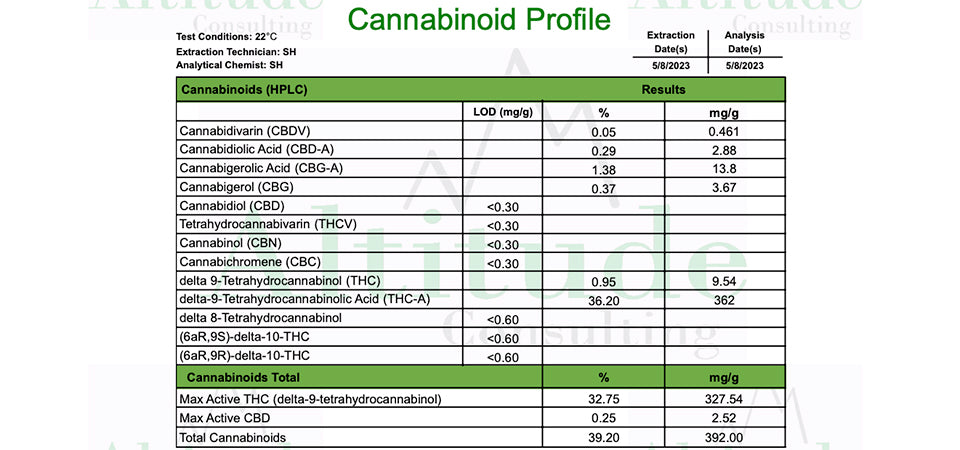Does THC Percentage Matter? Cannabis Experts Weigh In

A high THC percentage on the label looks attractive to consumers, but it doesn't tell the full story. In fact, research shows that people get just as high off cannabis flower with moderate levels of THC as they do when they smoke a cannabis strain with high levels of THC.
As a cannabis grower or processor, there are other considerations for creating premium products aside from the amount of THC. Your growing practices, post-harvest handling and processing equipment, packaging choices, and final storage environment all contribute greatly to the quality of the final product.
THC Percentage Doesn't Indicate Quality

Testing your products for cannabinoid levels and stating these levels accurately on the label is mandatory in many U.S. states. However, cannabinoid and even terpene testing can't determine quality. A bud could test at 30% THC but be moldy or harsh to smoke.
The only way to determine quality is through a combination of visual inspection, taste, smell, and the perceived effects after consumption. For concentrates, cannabis consumers often associate a lighter color with higher quality, although a dark amber color could indicate a later harvest time rather than a lower-quality product.
Pro tip: You can get lighter-colored concentrates by freezing your buds right after harvest, keeping them cold until you wash them for bubble hash, and freeze drying your bubble hash with a professional freeze dryer. This will not only result in a lighter color with greater shelf appeal but also helps preserve terpenes for a more flavorful end product.
High-THC Flower Doesn't Always Get People "More High"
A study published in 2020 found that smoking high-THC cannabis strains (with 24% THC content) had comparable perceived effects to smoking cannabis with 16% THC. Smoking 70% and 90% cannabis concentrates didn't result in more impairment than smoking flower, although the concentrate-consuming participants' plasma THC levels were more than double those of the participants who smoked flower.
Why wouldn't a higher THC percentage get people "more high?" To understand the effects of the cannabis plant, it's essential to understand the range of active compounds in the plant and the role each plays in the plant's effects.
Cannabinoids

According to NCCIH, there are over 100 cannabinoids aside from THC and CBD that occur in cannabis plants—in different percentages in different cannabis strains. This includes fairly well-known cannabinoids like CBG and CBN as well as other cannabinoids that aren't as well known like CBC, THCV, CBGV, and the acidic forms of all of the cannabinoids mentioned.
THC (tetrahydrocannabinol) is the most abundant cannabinoid in most marijuana plants, defined as cannabis plants with more than 0.3% THC by dry weight. It's the cannabinoid that is associated with the feeling of being high.
CBD (cannabidiol) is most abundant in hemp plants—cannabis plants with 0.3% THC or less by dry weight. This cannabinoid is non-intoxicating and is best known for its therapeutic properties.
There are marijuana strains with more than 0.3% THC but much higher levels of CBD, such as Harlequin, Harle-Tsu, AC/DC, and Charlotte's Web. These strains are popular with medical cannabis patients because they provide relief from things like chronic pain and seizures with very mild (if any) psychoactive effects.
Terpenes

Terpenes are aromatic compounds that give cannabis and other plants their fragrance and flavor.
The terpene profile of a given cannabis product not only creates that product's signature flavor but also alters its effects.
β-caryophyllene, for example, has a weak interaction with CB2 receptors.
Terpenes also have therapeutic effects of their own. β-myrcene, for example, has sedative and anesthetic properties, and strains with more than 0.5% myrcene are associated with couch-lock while strains with less than 0.5% myrcene tend to be more energizing.
Flavonoids
Flavonoids, particularly cannflavins (which are present in the plant Cannabis sativa), are known to have antioxidative and anti-inflammatory effects.
Thiols
Thiols are sulfur compounds (s-compounds) that are believed to be responsible for the skunk-like smell of cannabis. They are also understood to play a role in protecting cells against oxidative stress.
The Entourage Effect
The "entourage effect" refers to the way cannabinoids and terpenes work in concert to produce effects that each compound couldn't achieve alone. Consumers know from experience that a change in the ratio of certain compounds can alter the overall physiological response.
Once you start to take other cannabinoids, terpenes, and minor compounds into account, you will see that the levels of THC provide very little information about the overall quality or effects of cannabis products.
THC Percentages Are Important for Dosing Edibles
Edibles are the only product where THC percentage has true value for accurate dosing. A gummy or brownie with 50mg of THC will absolutely be more potent than one with 5mg of THC. The same applies to THC-infused beverages.
If you use bubble hash or rosin to make infused edibles, it's essential to test the THC levels in your concentrate before you start and dose your edibles with a high degree of precision. Most states with a legal cannabis industry set a limit of 10mg of THC per piece for edibles and 100mg of THC per packet.
Quality Is King
As a cannabis grower or processor, your number one priority should be producing high-quality products with loads of flavor and effects your customers can count on. That will sometimes mean growing and processing high-THC strains. But low-THC strains can do well too—particularly with first-time cannabis consumers and medical patients.
For the best results, find a niche, optimize your processes, and ask for customer feedback as well as sending your products for testing in a lab. Five-star ratings and glowing testimonials from your customers are worth far more than an "impressively" high THC percentage alone.



